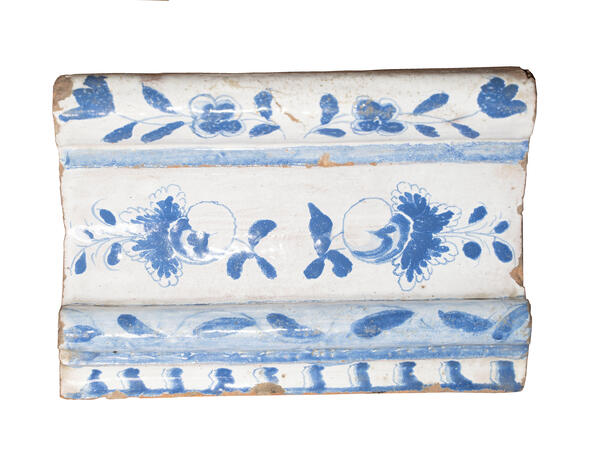The stove in Russia was considered not only a source of warmth and comfort, but also the heart of the house. The most common was the Russian stove, brick or adobe. However European tiled stoves appeared at the end of the 16th century.
The stoves were not only for heating, but also had decorative function. The stoves were faced with tiles - special box-shaped ceramic tiles. The front surface of the tiles could be smooth or embossed, sometimes had a glaze coating. They often depicted subject compositions, flower patterns.
In the 18th century, Peter the First brought to Russia the famous ‘Dutch’ tiles painted in blue cobalt on white enamel, which for many decades became the trendsetters of tile stove fashion.
The heating system in the houses of Sarepta was of a German or Dutch fireplace-heating type, with horizontal or vertical well passages and with fireboxes on the ground floor. Heating stoves on the first and second floors were faced with tiles. The tiles, tiles and stucco framing were produced by the local Niedenthal ceramic factory. The production of tiles is a complex process so the experienced craftsmen participated in baking bricks.
A Russian term for tiles stems from an ancient Russian term that may be translated as specimen. Specimens were ceramic decorations for the outer walls of churches, palaces and facing stoves in the state chambers till the end of the 17th century. The art of architectural ceramics has a long history. It stems from the times of Ancient Egypt, Assyria and Babylonia.
Wooden forms were used for stove tiles production and the rumpa (leg) of the tile was made manually or using a potter’s wheel. Rumpa is one of the biggest and most important “secrets” of a tile. Only because of rumpa the tile was not simply glued to the surface of the stove or fireplace, but mounted using a wire, which increases the reliability of the fastening.
Ceramics in Sarepta were traditionally painted in blue, white, green and yellow tones with floral designs. Fireplace and stove tiles were found during excavations at the site of the Niedenthal plant. They have perfectly preserved enamel surface and bright colors.
The stoves were not only for heating, but also had decorative function. The stoves were faced with tiles - special box-shaped ceramic tiles. The front surface of the tiles could be smooth or embossed, sometimes had a glaze coating. They often depicted subject compositions, flower patterns.
In the 18th century, Peter the First brought to Russia the famous ‘Dutch’ tiles painted in blue cobalt on white enamel, which for many decades became the trendsetters of tile stove fashion.
The heating system in the houses of Sarepta was of a German or Dutch fireplace-heating type, with horizontal or vertical well passages and with fireboxes on the ground floor. Heating stoves on the first and second floors were faced with tiles. The tiles, tiles and stucco framing were produced by the local Niedenthal ceramic factory. The production of tiles is a complex process so the experienced craftsmen participated in baking bricks.
A Russian term for tiles stems from an ancient Russian term that may be translated as specimen. Specimens were ceramic decorations for the outer walls of churches, palaces and facing stoves in the state chambers till the end of the 17th century. The art of architectural ceramics has a long history. It stems from the times of Ancient Egypt, Assyria and Babylonia.
Wooden forms were used for stove tiles production and the rumpa (leg) of the tile was made manually or using a potter’s wheel. Rumpa is one of the biggest and most important “secrets” of a tile. Only because of rumpa the tile was not simply glued to the surface of the stove or fireplace, but mounted using a wire, which increases the reliability of the fastening.
Ceramics in Sarepta were traditionally painted in blue, white, green and yellow tones with floral designs. Fireplace and stove tiles were found during excavations at the site of the Niedenthal plant. They have perfectly preserved enamel surface and bright colors.



